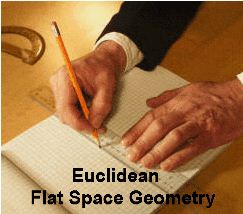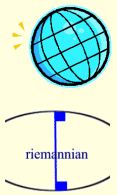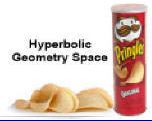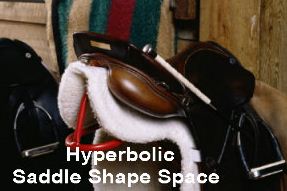Euclidean and Non-Euclidean Geometry
Euclidean Geometry
Euclidean Geometry is the study of geometry based on definitions, undefined terms (point, line and plane) and the assumptions of the mathematician Euclid (330 B.C.)
Euclid’s text Elements was the first systematic discussion of geometry. While many of Euclid’s findings had been previously stated by earlier Greek mathematicians, Euclid is credited with developing the first comprehensive deductive system. Euclid’s approach to geometry consisted of proving all theorems from a finite number of postulates (axioms).
Euclidean Geometry is the study of flat space. We can easily illustrate these geometrical concepts by drawing on a flat piece of paper or chalkboard. In flat space, we know such concepts as:

- the shortest distance between two points is one unique straight line.
- the sum of the angles in any triangle equals 180 degrees.
- the concept of perpendicular to a line can be illustrated as seen in the picture below.

In his text, Euclid stated his fifth postulate, the famous parallel postulate, in the following manner:
If a straight line crossing two straight lines makes the interior angles on the same side less than two right angles, the two straight lines, if extended indefinitely, meet on that side on which are the angles less than the two right angles.
Today, we know the parallel postulate as simply stating:
Through a point not on a line, there is no more than one line parallel to the line.
The concepts in Euclid’s geometry remained unchallenged until the early 19th century. At that time, other forms of geometry started to emerge, called non-Euclidean geometries. It was no longer assumed that Euclid’s geometry could be used to describe all physical space.
Non-Euclidean Geometry
Non-Euclidean geometries: are any forms of geometry that contain a postulate (axiom) which is equivalent to the negation of the Euclidean parallel postulate.
Examples:
1. Riemannian Geometry (also called elliptic geometry or spherical geometry):
A non-Euclidean geometry using as its parallel postulate any statement equivalent to the following:
If l is any line and P is any point not on l , then there are no lines through P that are parallel to l .
Riemannian Geometry is named for the German mathematician, Bernhard Riemann, who in 1889 rediscovered the work of Girolamo Saccheri (Italian) showing certain flaws in Euclidean Geometry.
Riemannian Geometry is the study of curved surfaces. Consider what would happen if instead of working on the Euclidean flat piece of paper, you work on a curved surface, such as a sphere. The study of Riemannian Geometry has a direct connection to our daily existence since we live on a curved surface called planet Earth.

What effect does working on a sphere, or a curved space, have on what we think of as geometrical truths?
- In curved space, the sum of the angles of any triangle is now always greater than 180°.
- On a sphere, there are no straight lines. As soon as you start to draw a straight line, it curves on the sphere.
- In curved space, the shortest distance between any two points (called a geodesic) is not unique. For example, there are many geodesics between the north and south poles of the Earth (lines of longitude) that are not parallel since they intersect at the poles.
- In curved space, the concept of perpendicular to a line can be illustrated as seen in the picture below.

2. Hyperbolic Geometry (also called saddle geometry or Lobachevskian geometry):
A non-Euclidean geometry using as its parallel postulate any statement equivalent to the following:
If l is any line and P is any point not on l , then there exists at least two lines through P that are parallel to l .
Lobachevskian Geometry is named for the Russian mathematician, Nicholas Lobachevsky, who, like Riemann, furthered the studies of non-Euclidean Geometry.
Hyperbolic Geometry is the study of a saddle shaped space. Consider what would happen if instead of working on the Euclidean flat piece of paper, you work on a curved surface shaped like the outer surface of a saddle or a Pringle’s potato chip.
 Unlike Riemannian Geometry, it is more difficult to see practical applications of Hyperbolic Geometry. Hyperbolic geometry does, however, have applications to certain areas of science such as the orbit prediction of objects within intense gradational fields, space travel and astronomy. Einstein stated that space is curved and his general theory of relativity uses hyperbolic geometry.
Unlike Riemannian Geometry, it is more difficult to see practical applications of Hyperbolic Geometry. Hyperbolic geometry does, however, have applications to certain areas of science such as the orbit prediction of objects within intense gradational fields, space travel and astronomy. Einstein stated that space is curved and his general theory of relativity uses hyperbolic geometry.

What effect does working on a saddle shaped surface have on what we think of as geometrical truths?
- In hyperbolic geometry, the sum of the angles of a triangle is less than 180°.
- In hyperbolic geometry, triangles with the same angles have the same areas.
- There are no similar triangles in hyperbolic geometry.
- In hyperbolic space, the concept of perpendicular to a line can be illustrated as seen in the picture below.

- Lines can be drawn in hyperbolic space that are parallel (do not intersect). Actually, many lines can be drawn parallel to a given line through a given point.
Graphically speaking, the hyperbolic saddle shape is called a hyperbolic paraboloid, as seen below.

